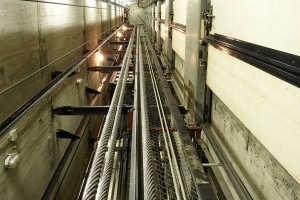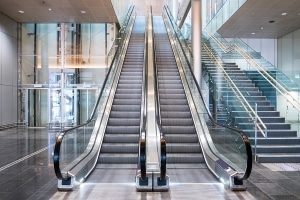
Elevator and Conveyor Technology
Planning of lifts and elevator systems
Technical building equipment (TGA) comprises a large number of different installations and systems whose task is to use the building for the function for which it is intended. This includes all permanently installed technical equipment both inside the building itself and in external areas.
In many commercial buildings or special buildings as well as in residential buildings over a certain height, the elevator and conveyor technology also plays an important role in the technical building equipment. Without this subfield of building services engineering, for example, neither a large industrial plant nor a hospital could function.
What is elevator and conveyor technology all about?
This refers to technical equipment used to transport people or goods. In technical building equipment, it also refers to systems that are located within the building or at least firmly connected to it or installed at a fixed location. Typical applications are escalators, lifts, elevator systems up to small transport systems. Colloquially, for example, forklifts or manually operated lift trucks are often also referred to as conveyor technology, but they are not included in technical building equipment because they are mobile devices.
Elevator technology or systems
The facilities are also called elevator or lift. These are systems used to transport people or loads between at least 2 different levels. The transport takes place in a cabin, a car or on a platform either in vertical or inclined direction.
In technical terms, an elevator system is considered to be a lift if the lifting height is at least 1.80 m, the car is guided and there are at least 2 fixed access points.
The first elevators were built as dumbwaiters in the 18th century and were operated manually. The elevator only experienced its breakthrough in building services engineering in the second half of the 19th century, when the American Elisha G. Otis invented the fall-safe elevator. From that time on, elevators spread unstoppably and made the modern architecture of the skyscraper skyline possible in the first place. Incidentally, elevators are the safest mass transportation system thanks to the extensive safety measures in place.
Moving staircases, as escalators are called in the technical language, occupy a special position. They are used to transport people at an angle between 2 levels. If the transport takes place in a horizontal direction, one speaks of a moving walkway.
Conveyor technology
The conveyor technology is used to transport goods. This refers to firmly installed equipment, including for example:
- Conveyor belts
- Lifting platforms
- Access facilities
- Car parking systems
This also includes special equipment such as roller conveyors, belt bucket elevators, belt conveyors or automatic truck loading systems.
Tasks of engineers in the field of elevator and conveyor technology
In this area, the scope of tasks has increased more and more in recent years. The client expects the engineer to provide neutral advice in the planning of new buildings, independent of the manufacturer. In this area, the main focus is on the installation of complete systems and their integration and networking with other building equipment.
For some time now, the modernisation or optimisation of existing systems has also been developing into an increasingly important field of activity.
Another area whose importance continues to grow is lift management, which serves to improve the efficiency of conveyor systems.
Summary
Elevator and conveyor technology are part of the technical building equipment. This refers to fixed installed equipment used to transport people or goods. The most widespread are lifts, which are available in countless variants and designs.
Conveyor belts are also frequently encountered. Modern conveyor systems include car parking systems and automatic truck loading systems. Elevator and conveyor technology only functions smoothly if it is closely linked to other systems in the building equipment, such as measurement and control technology.




